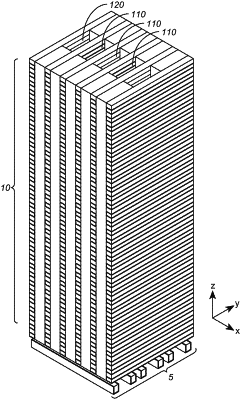| CPC H10B 43/27 (2023.02) [H01L 21/31144 (2013.01); H01L 21/32139 (2013.01); H01L 21/31116 (2013.01)] | 21 Claims |

|
1. A method for high aspect ratio etching, comprising:
preparing above a surface of a semiconductor substrate a plurality of multi-layers, stacked one on top of another along a first direction substantially orthogonal to the surface of the semiconductor substrate, wherein each multi-layer comprising a first layer and a second layer, wherein the first layer comprises a first dielectric material and the second layer comprises a first material;
patterning and etching the multilayers along the first direction using a first mask to form a first set of trenches that divide the multi-layers into a first group of multi-layer stacks, wherein each of the first set of trenches extends along a second direction substantially parallel to the surface of the semiconductor substrate;
filling the first set of trenches with a second dielectric material;
patterning and etching the first group of multi-layer stacks along the first direction using a second mask to form a second set of trenches that create, out of the first group of multi-layer stacks, a second group of multi-layer stacks, wherein each of the second set of trenches extends along the second direction parallel the first set of trenches;
filling the second set of trenches with the second dielectric material; and
selectively etching a first portion of the second dielectric material in the first and second sets of trenches to provide a first plurality of shafts that extends along the first direction;
depositing a semiconductor layer of a first conductivity conformally; and
filling each shaft with a third dielectric material.
|